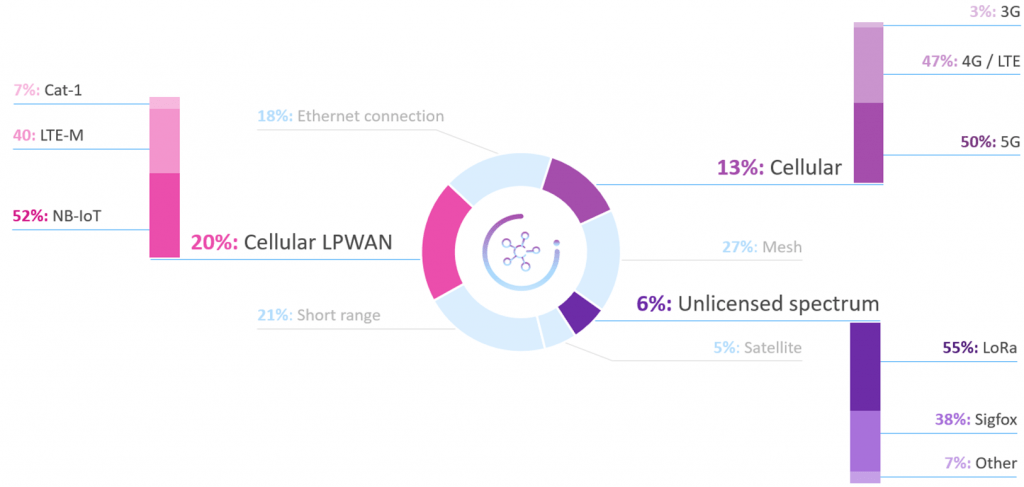Diversity in the scope, aims and challenges for IoT deployments exist in every use case and vertical – but the Asia-Pacific region brings its own unique factors from social, economic, and technological sides that all impact connectivity choices.
In Telenor IoT´s Asian IoT Megatrends report, we explore the drivers and differentiating factors of IoT deployment in APAC, as well as examples of customer success stories from key verticals.
No other region has such diversity and influence in the following areas:
These factors continue to shape the IoT connectivity picture in APAC – where China drives NB-IoT to be the most popular LPWAN connectivity overall, and LoRa is the most popular unlicensed LPWAN network. With the sunsetting of 2G and 3G in many markets, enterprises are increasingly looking towards higher bandwidth IoT solutions that embrace 5G and LTE-M – a big factor in the 22% growth in cellular IoT module revenue expected from 2021 ($1.9 billion) to 2026 ($2.4 billion) in the Asia-Pacific region, compared to a 1% drop in the Rest of the World.
Managed connectivity also remains a go-to solution for enterprises in the region to ensure reliable and stable networks - where network connectivity services are outsourced to a service provider, typically composed of aspects such as service agreements, hardware, and network support. This service provides benefits such as reduced network integration complexity, reliable uptime, and potential cost savings in acquiring both hardware and talent.
“What type of connectivity is being/will be used for your IoT solutions?” (‘Select all that apply’, normalised to 100%)

Source: Omdia
In fact, APAC enterprises are more heavily reliant than usual on their partners in supporting their IoT deployments overall. Whilst “Lack of Internal IoT Experience” only ranks as the #8 biggest challenge to IoT deployment in the Rest of the World, this is the #4 challenge in APAC – almost equal with the top three challenges of “Ensuring data, network, and device security”, “Ensuring data privacy or governance”, and “Complexity of integrating with business processes/OT”.
Cybersecurity concerns – both real and perceived – will always slow IoT adoption. This heightened through the pandemic as huge workloads and processes were digitalized and shifted to the internet, but the unprepared nature created challenges (e.g. poor patch management, careless users) which make information easy targets for malicious actors. Indeed, increased remote working may push more businesses to consider zero trust as an option, despite potential issues in terms of accessibility and ease of use.
Ultimately, IoT security vulnerabilities and stolen information risk major damage to an enterprise’s business operations. Recent attacks have only raised these concerns:
Enterprises are therefore wary of the digital technologies they implement. Tensions around security are keenly felt in Asia-Pacific, amid major tussles between countries such as China, India, Indonesia, and Pakistan – meaning cybersecurity is always a priority for any IoT deployment in the region.
According to Omdia’s survey, security concerns remain one of the biggest pain points for enterprises in their IoT implementation journey, where 30% of respondents in APAC indicated that ensuring data, network, and device security are important to them. Security therefore needs to be forefront of new vendor solutions and enterprise projects to create a level of confidence for enterprises to utilize their offerings.
“What are your greatest concerns on IoT security?” (% of enterprises ranking as top concern)

Source: Omdia Enterprise IoT Survey
As with sustainability, the introduction/revamping of regulations and policies on cybersecurity is also driving change. For example:
Beyond data security, enterprises also require secure data privacy and governance. Data from a single endpoint may not carry significant weight, but data received from multiple sources likely means the creation of a database holding sensitive information. Omdia expects service providers to establish effective governance to safeguard these data and to not openly share this information with other parties with the purpose of gaining profits.
In all cases, no matter which vertical or use case, it’s the provision of secure, trusted, and stable IoT and connectivity technology that make the backbone of any IoT solution.